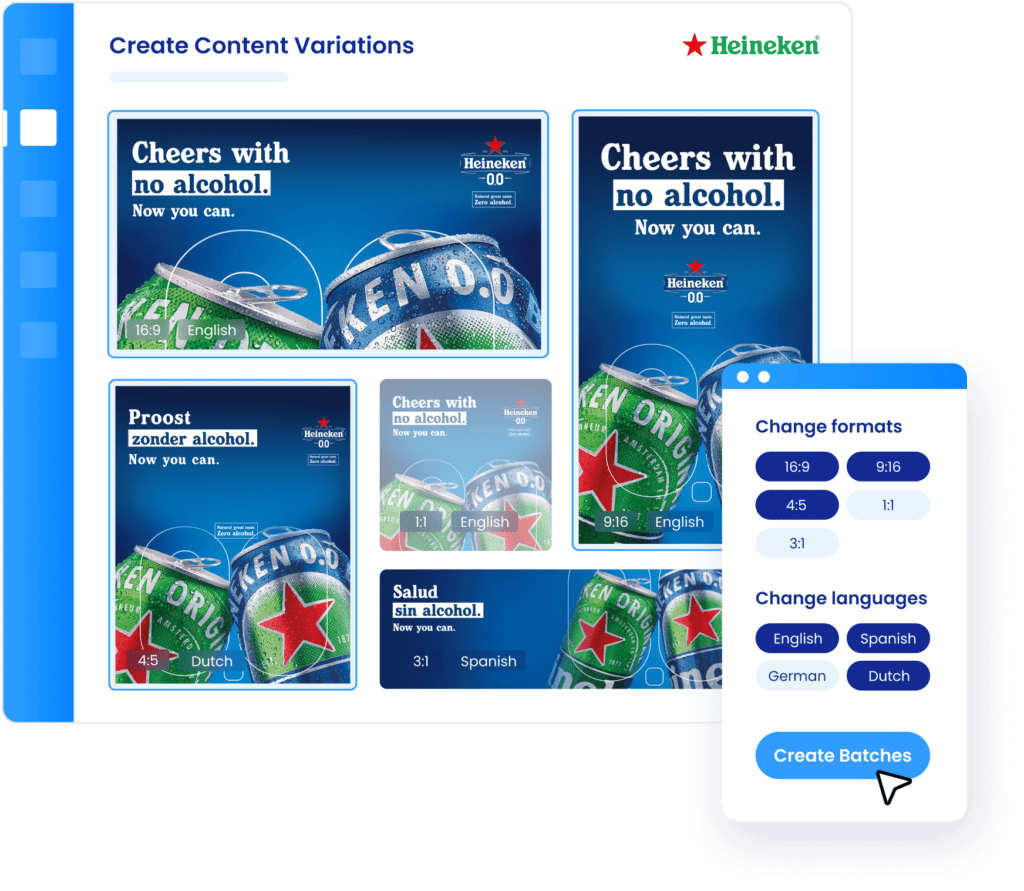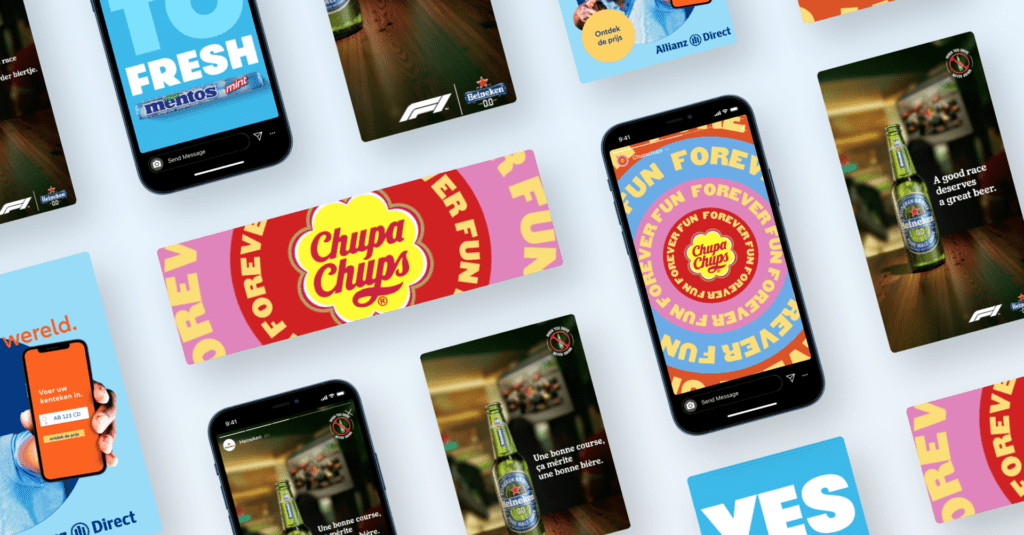Until today, little has been said and written regarding Creative Automation as it’s still a fairly new concept used in advertising. Therefore, we’ve created a comprehensive glossary which offers a series of simple, bite-sized explainers to help anyone understand what Creative Automation is, how it works, and how it’s changing the advertising world around us.
A/B testing
A/B testing is a method of comparing two or more variants of a creative against each other to determine which variant performs best. Typically, there are significant differences between the variants and they could be altogether different.
A/B testing, also known as split-testing, refers to an experimentation process where your creative versions are shown at random to similarly-sized audiences and determine which variant performs best for a given conversion goal or business metric.
For marketers and creatives, these types of experiments are valuable as it eliminates lots of guesswork and enables them to make data-based iterations.
Ad fatigue
Ad fatigue occurs when your audience sees your ads so often they lose interest and stop paying attention to them, causing a decrease in campaign performance. When this happens, campaigns become less effective and ultimately lead to a decrease in Return on Investment.
Simple changes can prevent this phenomenon from happening:
A/B testing – various ads lead to the optimization of the target audience
Ad rotation – multiple versions of the same ad breaks the monotony the audience might experience
Dynamic ads – by making various elements within the advertising template dynamic, it’s easier for creatives to make changes in elements like copy, CTA, background color, scene order, tone of voice, etc. That way, content can be personalized to any target audience
Ad format
Choosing the right ad format is not only important because of the canvas you have to work on and the layout you have to design, but also because different sizes generate different impressions and performance.
Ad personalization
Personalizing advertisements is the process of using customer data and/or demographic information to increase the relevancy of an ad. Tailoring ads to an individual leads to an increase in engagement and ultimately to an increase in sales.
After Effects extension
The Storyteq After Effects extension is compatible with a wide variety of After Effects workflows. It allows you to create a dynamic video template from your existing Adobe After Effects project. Turning your files into templates, it makes it easier to personalize your advertising and scale creative production.
Brand compliance / brand consistency / brand homogeneity
Brand consistency ensures that your brand is easily recognizable across marketing channels and different touchpoints. Delivering brand messaging (core messages, visual branding, and other brand elements) in a consistent manner, leads to a solidified brand identity and unified experience for both existing and potential customers. Over time, customers will be more likely to remember your brand.
Creative asset
Creative assets are files such as static images, videos, and other digital media files that can be uploaded to provide ad content to a target audience.
Creative Automation
Creative Automation is the process of leveraging technology to scale your asset production by automatically adapting and changing certain aspects of your banner, image, or video content such as size, format, CTAs, and graphic elements to enable high-volume content creation for high-volume demand.
Creative Automation helps remove bottlenecks in the creative production process by shortening, personalizing, and making it easier for your organization. Without the option of creating and adapting visual assets like banners or videos with ease, designers and marketers would need to manually create each asset to ensure high quality and brand consistency.
Creative iteration
Creative iteration is the process of tapping into templates to speed up the overall production process, and change any creative element within minutes. This way, you can iterate and communicate faster, enabling A/B testing, personalized video campaigns, and DCO campaigns.
Creative operations / creative workflows
Creative operations describes the formal structure and workflow a brand sets up to unify its resources and assets, and ultimately streamline processes and performance. Broadly, creative operations is defined as making the creative process within a business more structured, helping team members move faster and produce better work.
Creative scaling
Creative scaling emphasizes the solution for global brands that need to scale their creative production process in order to drive down costs, facilitate local markets, and ensure brand consistency.

Datasheet
Examples of datasheets are product feeds, pricing lists, customer data, or translation sheets. Connecting these to a Creative Automation platform enables creative and marketing teams to output all creative versions they need at once.
Dynamic banners
Dynamic banners is a type of banner that can be customized automatically in real-time to adapt content and promotions tailored to each user. The use of behavioural data, such as product affinities, geo-location, or CRM data, ensures that any individual user will be exposed to the most appropriate banner. This increases both the overall engagement and conversion rate.
Dynamic creative
Dynamic creatives consist of a base creative (video, image, or banner) in which elements are set to be swappable. These are called “dynamic creatives” and are typically text, images, sound, video, or even entire scenes. This gives you the ability to instantly create customized videos or banners at scale without sacrificing creative quality.
Dynamic Creative Optimization (DCO)
Dynamic Creative Optimization is a display ad technology that is used to create personalized advertisements. In this process, the same base creative is used, while certain elements of the ad are adjusted and based on customer data, geolocation, and past performance.
This technique enables you to create multiple iterations at speed. By combining the dynamic elements with analytics, it becomes easier to resonate with your audience and optimize creatives for an increase in relevance and ad performance.
Dynamic element
A dynamic element is something in a piece of creative that can be changed from a data trigger. This can be the aspect ratio of the video, a text element, an image element, a video element, etc.
Localization
Ad localization is the process of adapting content to fit specific market needs, expectations, culture and socio-economic norms. By adjusting the copy, design and layout of an ad, it becomes easier to resonate with the local target audience. Due to localization, marketing campaigns can become more cost-effective and more effective in terms of overall ad performance.
Multivariate testing
Multivariate testing is a method of comparing two or more variants of a creative against each other wherein you test a higher number of elements (for example, testing different CTAs, copies, background colors and visuals simultaneously) to measure the effectiveness each design combination has on the ultimate goal.
Using the same core mechanism as A/B testing, it refers to an experimentation process where your creative versions are shown at random to similarly sized audiences and determines which variant performs best for a given conversion goal and drives business metrics.
This advanced testing method is even more valuable for marketers and creatives as it tests multiple combinations of variables simultaneously. It gives insights which elements play the biggest roles and how variations perform when combined. The outcomes help creatives and marketers save time, money, and draw conclusions in a shorter amount of time.
Personalized video
Within personalized video marketing, data is combined with video content in order to become more relevant to the target audience or an individual. By including personalized elements (varying from CRM data, analytics data, location, etc.) into video, the brand message resonates better with your target audience.

Programmatic creative
Programmatic creative refers to the set of advertising tools that add speed, scalability, and automation to the creative production process. Combining data with technology enables the production of hyper-relevant display ads that are tailored and customized to the viewer. Ultimately, this leads to an optimization in the performance of display campaigns.
Resizing
Using the Template Builder, you can easily add different sizes to your template based on your Original Size, using our smart resizing algorithm; the original size is the canvas size you build your creative in. Once you have multiple sizes within your template, you can toggle between them simply by clicking on the size name below the canvas.
Template
An advertising template is a framework that can be customized and made your own. By making use of templates, it becomes easier for creative and marketing teams to create digital content while staying brand consistent. Besides, designers can focus again on their creative efforts (instead of re-making the entire ad), saving both time and money.
Template Builder
Storyteq’s Template Builder is a low-entry, in-browser, web-based editor that helps you with:
- The creation of video, image, and banner ads
- Adapting your creative to multiple sizes
- Scaling your creative by creating a video, image-only, or banner template out of it; by labelling certain elements as dynamic thus making these changeable for the creating media with the Storyteq platform
Conclusion
Whether you are looking to implement a Creative Automation platform to your current MarTech stack, or optimizing existing advertising strategies, we hope this blog has helped you learn more about how marketing and creative teams can benefit from Creative Automation.
Interested to learn more about this solution? Request a personalized Storyteq demo via this link and find out why many companies and agencies rely on Storyteq as their Creative Automation platform.



